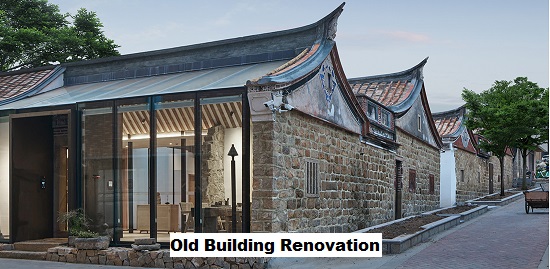Renovating an old building can be a rewarding project that brings a piece of history back to life. Not only does it preserve architectural heritage, but it also can be more sustainable and cost-effective than building anew. In this guide, we will explore the top 10 ways to renovate an old building, covering everything from structural assessments to incorporating smart technology.
Assess the Structure
Initial Inspection
Before diving into any renovation project, it’s crucial to conduct a thorough initial inspection. This involves checking the foundation, roof, walls, and all major systems. Look for signs of damage like cracks, leaks, and mold. This first step will give you a clear understanding of what you’re working with.
Hiring Professionals
To ensure nothing is overlooked, hire professionals such as structural engineers and architects. They can provide detailed reports on the building’s condition and offer expert advice on necessary repairs and upgrades.

Understanding the Building’s History
Researching the history of your building can provide valuable insights into its original construction methods and materials. This knowledge is crucial when deciding which elements to preserve and how to approach renovations.
Plan and Budget
Setting Realistic Goals
Set clear, realistic goals for your renovation project. Determine what you want to achieve and create a vision for the end result. Be specific about the features you want to restore, upgrade, or add.
Creating a Detailed Budget
Develop a comprehensive budget that covers all aspects of the renovation, including materials, labor, permits, and contingency funds for unexpected expenses. Detailed planning can help prevent budget overruns and project delays.
Prioritizing Projects
Not all renovation tasks are equally urgent. Prioritize projects based on their impact on safety, functionality, and aesthetics. For instance, structural repairs should come before cosmetic updates.
Preserve Historical Features
Identifying Key Elements
Identify the building’s historical features that are worth preserving, such as original woodwork, stained glass windows, or unique architectural details. These elements add character and value to the property.
Techniques for Preservation
Use preservation techniques that respect the building’s original construction. This might include gentle cleaning methods, using compatible materials for repairs, and avoiding invasive procedures that could damage historical features.
Benefits of Retaining Character
Retaining the building’s original character not only honors its history but can also enhance its market value. Buyers often appreciate the charm and authenticity of well-preserved historical elements.
Update Electrical and Plumbing Systems
Importance of Modern Systems
Old electrical and plumbing systems can be inefficient and potentially hazardous. Updating these systems is essential for safety and functionality.
Common Challenges and Solutions
Renovating electrical and plumbing in old buildings can be challenging due to outdated layouts and materials. Hire experienced professionals who specialize in older properties to navigate these challenges effectively.
Ensuring Safety Standards
Ensure that all updates comply with current safety standards and building codes. This includes installing GFCI outlets, proper grounding, and modern piping materials.
Improve Energy Efficiency
Insulation and Windows
Improving insulation and upgrading windows can significantly boost your building’s energy efficiency. Consider adding insulation to walls, roofs, and floors, and install double or triple-glazed windows to reduce heat loss.
Energy-Efficient Lighting and Appliances
Replace old lighting fixtures and appliances with energy-efficient alternatives. LED lighting and Energy Star-rated appliances can reduce energy consumption and lower utility bills.
Renewable Energy Options
Explore renewable energy options such as solar panels or geothermal heating. These technologies can further enhance the building’s sustainability and reduce long-term energy costs.
Upgrade the Interior Design
Blending Old and New Styles
Create a harmonious blend of old and new styles by incorporating modern design elements that complement the building’s original features. This can create a unique and inviting interior space.
Choosing Sustainable Materials
Opt for sustainable and eco-friendly materials for your renovations. Reclaimed wood, recycled metal, and low-VOC paints are excellent choices that minimize environmental impact.
Modernizing Kitchens and Bathrooms
Kitchens and bathrooms are key areas for modernization. Update these spaces with contemporary fixtures, efficient layouts, and high-quality finishes to enhance comfort and functionality.
Enhance Structural Integrity
Addressing Foundation Issues
Foundation issues can compromise the entire structure. Address any foundation problems early in the renovation process to ensure the building’s long-term stability.
Strengthening Load-Bearing Walls
Reinforce load-bearing walls with modern materials to support additional weight and improve overall structural integrity. This is especially important if you plan to add new features or make significant changes.
Using Modern Materials for Support
Incorporate modern materials like steel beams or advanced composites to enhance the building’s support structure without altering its appearance.
Focus on Exterior Restoration
Roofing and Siding
Restoring or replacing roofing and siding can protect the building from weather damage and improve its appearance. Choose materials that match the original as closely as possible.
Landscaping and Outdoor Spaces
Don’t neglect the building’s exterior surroundings. Well-designed landscaping and outdoor spaces can enhance curb appeal and provide additional areas for enjoyment.
Enhancing Curb Appeal
Simple updates like repainting the exterior, adding new lighting, and updating entryways can dramatically improve the building’s curb appeal, making it more attractive to visitors and potential buyers.
Incorporate Smart Technology
Benefits of Smart Home Features
Smart home technology can make your building more convenient and efficient. Features like automated lighting, security systems, and climate control add modern comfort to historical charm.
Integrating Technology Seamlessly
Ensure that smart technology is integrated seamlessly to maintain the building’s aesthetic. Conceal wiring and devices to keep the focus on the building’s architectural features.
Future-Proofing the Building
Incorporate technology that can be easily updated as new advancements emerge. This approach keeps your building up-to-date without requiring frequent overhauls.
Address Accessibility
Importance of Accessibility
Making your building accessible ensures it can be enjoyed by everyone, including those with disabilities. Accessibility is not only a legal requirement but also a moral obligation.
Solutions for Different Needs
Implement solutions such as ramps, wider doorways, and accessible restrooms. These modifications can be made without compromising the building’s historical integrity.
Making Historical Buildings Accessible
Work with experts in historical preservation to find creative solutions for accessibility that respect the building’s original design and materials.
Navigate Legal and Zoning Requirements
Understanding Local Regulations
Familiarize yourself with local regulations and zoning laws that apply to your renovation project. These rules can impact what changes you are allowed to make.
Securing Necessary Permits
Ensure you obtain all necessary permits before starting your renovation. Failure to do so can result in fines and delays.
Working with Preservation Societies
If your building is listed on a historical register, work closely with preservation societies to ensure your renovation complies with their guidelines and standards.
Choose the Right Contractors
Vetting Professionals
Carefully vet contractors to find those with experience in renovating old buildings. Check references, review past projects, and verify credentials.
Importance of Experience with Old Buildings
Contractors with experience in old buildings understand the unique challenges they present. Their expertise can save time, money, and headaches.
Managing the Renovation Team
Effective management of your renovation team ensures the project stays on track. Regular communication and clear expectations are key to a successful renovation.

Sustainable Renovation Practices
Eco-Friendly Materials
Use eco-friendly materials throughout your renovation to reduce environmental impact. Bamboo, cork, and recycled materials are excellent choices.
Waste Reduction Techniques
Implement waste reduction techniques such as recycling old materials and minimizing demolition debris. This approach is both environmentally responsible and cost-effective.
Long-Term Sustainability Goals
Set long-term sustainability goals for your building. This might include reducing energy consumption, using renewable resources, and maintaining the building’s ecological footprint.
Conclusion
Renovating an old building is a fulfilling project that combines preserving history with modern functionality. By following these top 10 renovation strategies, you can ensure your project is successful, sustainable, and stylish. Whether you’re updating electrical systems, enhancing structural integrity, or incorporating smart technology, each step brings you closer to revitalizing a piece of history.
FAQs
1. How do I start renovating an old building? Start with a thorough assessment of the building’s condition, set clear goals, and develop a detailed budget. Hiring experienced professionals is also crucial.
2. What are the most important factors to consider? Safety, structural integrity, and preserving historical features are key considerations. Additionally, plan for modern updates like electrical systems and energy efficiency.
3. How can I preserve the character of my building? Identify and retain key historical features, use preservation techniques, and choose materials that match the original construction as closely as possible.
4. What are common challenges in renovating old buildings? Common challenges include outdated electrical and plumbing systems, structural issues, and navigating legal and zoning requirements. Hiring professionals with experience in old buildings can help address these issues.
5. How can I make my old building more energy-efficient? Improve insulation, upgrade windows, use energy-efficient lighting and appliances, and consider renewable energy options like solar panels.